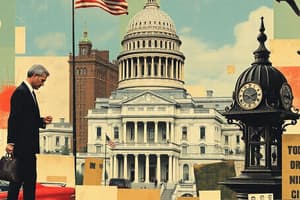Podcast
Questions and Answers
What is the federal budget?
What is the federal budget?
The taxing and spending plan of the national government.
A budget deficit occurs when the government's revenues are greater than its outlays.
A budget deficit occurs when the government's revenues are greater than its outlays.
False (B)
Which of the following are mandatory spending programs?
Which of the following are mandatory spending programs?
- Health and Human Services
- Medicaid (correct)
- Social Security (correct)
- Defense spending
What percentage of the total budget is discretionary spending?
What percentage of the total budget is discretionary spending?
Discretionary spending can be adjusted by Congress on a yearly basis.
Discretionary spending can be adjusted by Congress on a yearly basis.
What was the estimated present-value cost of the student loan forgiveness plan in 2022?
What was the estimated present-value cost of the student loan forgiveness plan in 2022?
Who made the statement about the national debt being an internal debt owed by the Nation?
Who made the statement about the national debt being an internal debt owed by the Nation?
A budget surplus occurs in years when government spending is less than its ______.
A budget surplus occurs in years when government spending is less than its ______.
Flashcards are hidden until you start studying
Study Notes
Federal Budget & National Debt Challenges
- FY 2023 Budget Breakdown: Includes spending categories such as:
- Social Security: 28.6%
- Medicare/Medicaid: 27.6% (combined)
- Defense: 15.8%
- Interest on Debt: 8.4%
- Other Mandatory Spending: 14.2%
- Discretionary Spending: 9.9%
- Other Spending: 1.4%
- Misconceptions About Budgeting: Focus on the difference between Outlays and Receipts, as well as how Budget Deficits contribute to the National Debt, and a Budget Surplus can reduce it.
- Mandatory Spending: Consists of programs required by existing law, including:
- Social Security
- Medicare
- Medicaid
- Veterans benefits
- Food stamps
- Interest on national debt
- Considered "Entitlements" - if you meet eligibility requirements, you're entitled to benefits or services.
- Constitutes about 70% of total federal spending.
- Discretionary Spending: Spending Congress can adjust annually, includes:
- Department of Defense (DoD)
- Health and Human Services
- Veterans Administration
- State Department
- Homeland Security
- Only about 30% of the total budget with roughly half going to defense.
- 2022 Federal Budget: Student loan program outlays were unusually high in 2022, due to President Biden's student loan forgiveness plan, which was recorded as an increase in outlays in the FY 2022 budget.
- Estimated cost of student forgiveness plan was $379 billion by the Biden Administration.
- US Public Debt: Majority of the US public debt is held by:
- Federal Agencies: 35%
- Foreign Investors: 30%
- U.S. Investors (non-Federal): 29%
- Federal Reserve: 6%
- US Public Debt Burden: Compared to other countries, the US has the largest national debt burden as a percentage of GDP.
- Franklin D. Roosevelt's Perspective on the National Debt: Roosevelt believed that a reasonable national debt was not a problem, as long as the government was putting the borrowed capital and labor to good use. He highlighted that the debt was an "internal debt owed not only by the Nation but to the Nation."
Studying That Suits You
Use AI to generate personalized quizzes and flashcards to suit your learning preferences.




